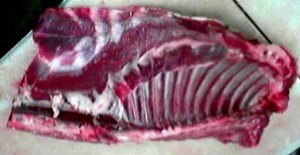I can’t decide whether the ancient Egyptians were lucky not to have to try to fit things around the Christmas shopping, or whether equipping their tombs was simply an endless version of it: going out with a list of stuff to buy, lugging it home, hiding it away where the kids can’t see it… I suppose that makes the afterlife an endless Boxing Day; one long procession of visitors and leftover food. Well, at least they brought their own cold cuts. And they were the leftovers of the gods.
Anyway, I have surfaced briefly from the pre-Christmas preparations to bring you the word:

 imakhy; the revered one. No, not Santa Claus; “the revered one” is the way the Egyptians customarily referred to the deceased person.
imakhy; the revered one. No, not Santa Claus; “the revered one” is the way the Egyptians customarily referred to the deceased person.
Imakhy is quite a long word by offering formula standards. However, it contains some characters we’ve had before, like the ghosts of Christmas past. You’ll recognise the first character as the flowering reed they used to convey the i sound. You’ll also notice there are two of them at the end of the word. Where they occur in pairs, they are conventionally written as a y.
The circular sign you’ll also recognise as the placenta symbol conveying the kh sound, so there is only one new symbol here:
Yes, all those sounds crammed into a single hieroglyph, like goodies in a Christmas stocking. Then you pull them out and realise you’ve got half of them already. The i and the kh symbols are only there as emphasis for those sounds; they don’t actually add anything extra. What is it? you wonder, just as many of you are wondering as you reach into the office Santa’s sack and your fingers close round that Secret Santa package… is it a comb? Is it a toothbrush?
No, it’s a much choicer morsel than that: it’s a section of backbone (animal) with the spinal cord protruding from the end. See the ribs?
You can count them better in this painted version from an (cracked) coffin:
There are six in this version, but you don’t have to be that accurate. I usually draw a horizontal line ending in a loop, then add four or five long, narrow, upright loops for the ribs. Bring two or three of them down below the horizontal line, to show the bumps of the vertebrae.
The imakh symbol is an ideogram – a picture of the thing itself. Imakh originally meant this cut of the carcass, and that word sounded similar to the word “revered”, so that was the sign they used to write it. The -y ending conveys the “one”. But I promised we wouldn’t get into grammar, and I won’t force it on you now. After all, it is Christmas.




Thanks for showing this letter! I just knew the 3w symbol, which is graphically near to the im3h…
Comment by jpgalhano — December 9, 2009 @ 10:03 pm |
Yes, with the spinal cord protruding at both ends. Interesting to see how the Egyptians distinguished between them. Writing this blog has really brought home to me how many hieroglyphs are derived from baking and butchery.
Comment by susanllewellyn — December 10, 2009 @ 9:23 am |
As usual Susan your witty description makes your post an enjoyable read. It’s interesting to see the hieroglyph compared to a photograph.
Comment by Vincent Brown — December 10, 2009 @ 3:33 am |
Glad you like it!
Comment by susanllewellyn — December 10, 2009 @ 9:19 am |